Farin G. Curves and Surfaces for CAGD. A Practical Guide
Подождите немного. Документ загружается.

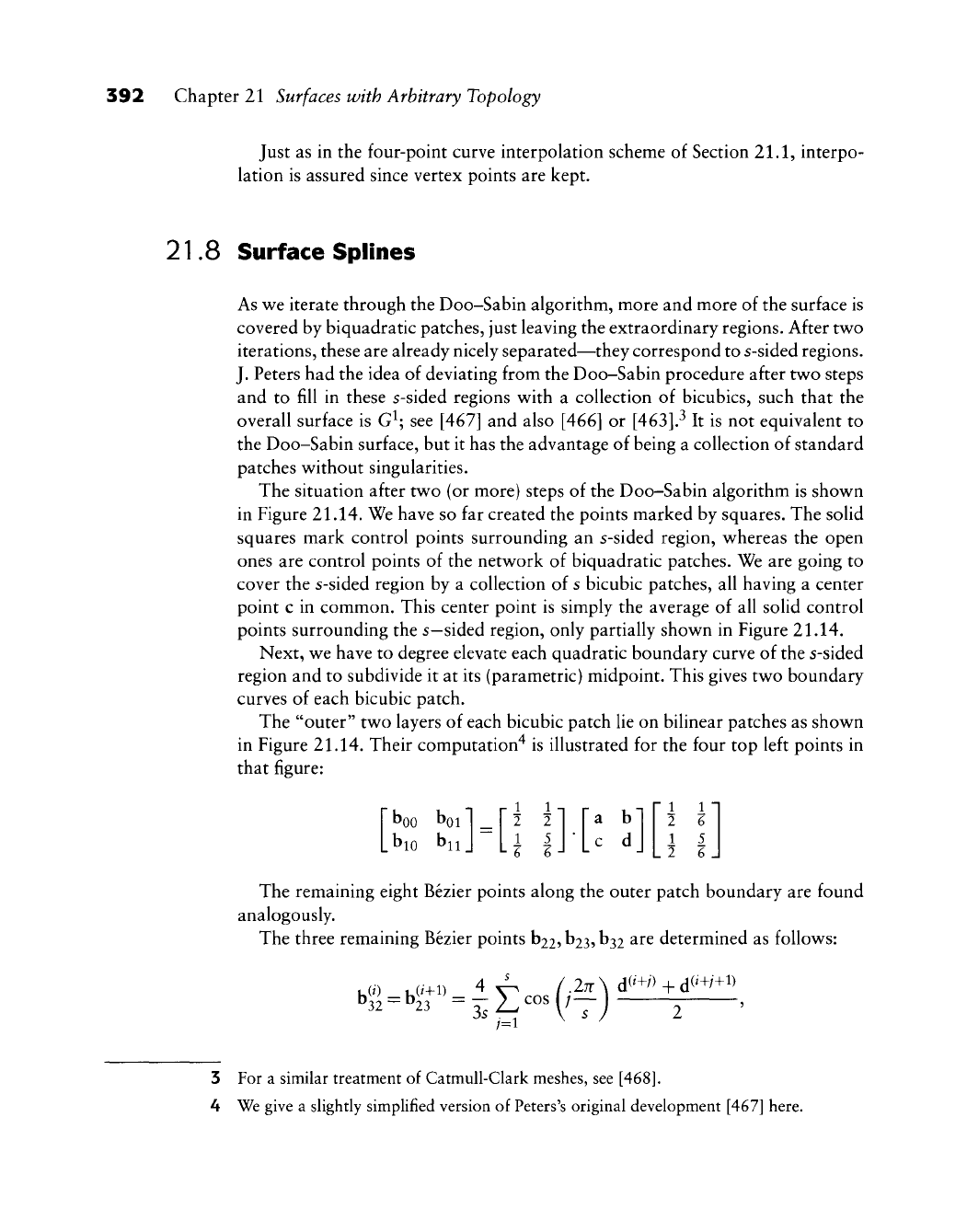
392 Chapter 21 Surfaces with Arbitrary Topology
Just as in the four-point curve interpolation scheme of Section 21.1, interpo-
lation is assured since vertex points are kept.
21.8 Surface Splines
As
w^e
iterate through the Doo-Sabin algorithm, more and more of the surface is
covered by biquadratic patches, just leaving the extraordinary regions. After tw^o
iterations, these are already nicely separated—they correspond to s-sided regions.
J. Peters had the idea of deviating from the Doo-Sabin procedure after two steps
and to fill in these s-sided regions w^ith a collection of bicubics, such that the
overall surface is G^; see [467] and also [466] or
[463].^
It is not equivalent to
the Doo-Sabin surface, but it has the advantage of being a collection of standard
patches without singularities.
The situation after two (or more) steps of the Doo-Sabin algorithm is shown
in Figure 21.14. We have so far created the points marked by squares. The solid
squares mark control points surrounding an s-sided region, whereas the open
ones are control points of the network of biquadratic patches. We are going to
cover the s-sided region by a collection of s bicubic patches, all having a center
point c in common. This center point is simply the average of all solid control
points surrounding the s—sided region, only partially shown in Figure 21.14.
Next, we have to degree elevate each quadratic boundary curve of the s-sided
region and to subdivide it at its (parametric) midpoint. This gives two boundary
curves of each bicubic patch.
The "outer" two layers of each bicubic patch lie on bilinear patches as shown
in Figure 21.14. Their computation"^ is illustrated for the four top left points in
that figure:
'nj [\ \[l
boo boi
1
^ r 2 2 1 fa b
bio
bii
I
u I rl c d
1 1
2 6
1 i
2 6
The remaining eight Bezier points along the outer patch boundary are found
analogously.
The three remaining Bezier points hii^
b23,
hi^i
are determined as follows:
.27r\ d(^+/)+d(^+/+i)
,«.br=iE-(,f)
3 For a similar treatment of Catmull-Clark meshes, see
[468].
4 We give a slightly simplified version of Peters's original development [467] here.
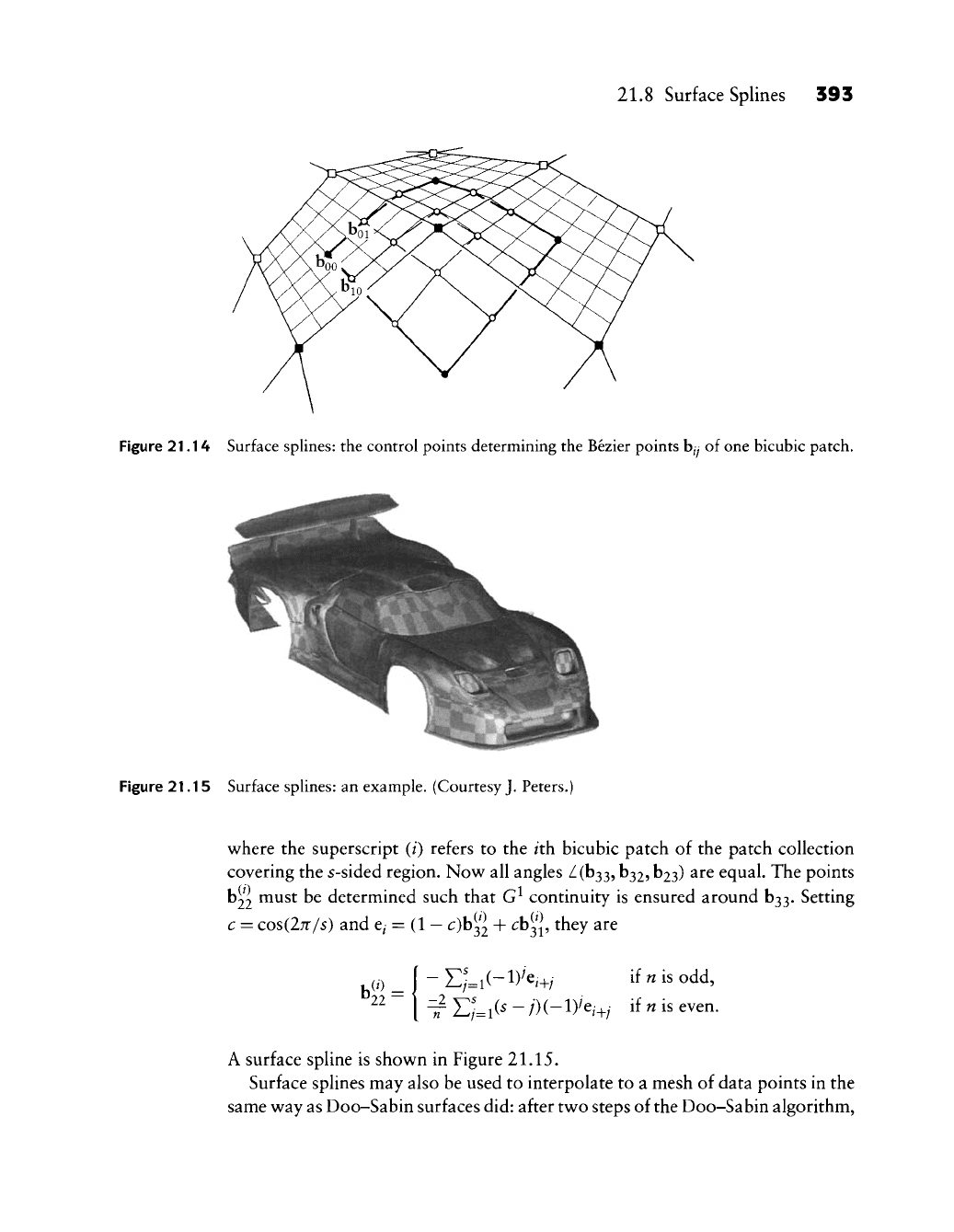
21.8 Surface Splines 395
Figure 21.14 Surface splines: the control points determining the Bezier points
b/y
of one bicubic patch.
Figure 21.15 Surface splines: an example. (Courtesy J. Peters.)
where the superscript (/) refers to the /th bicubic patch of the patch collection
covering the s-sided region. Now all angles
Z(b33,
^32?
^23) are equal. The points
b22 must be determined such that G^ continuity is ensured around 633. Setting
c = Qos{ln/s) and e^ = (1
— c)\y^2
+ ^^-^v ^^^Y ^^^
D22-
E;=i(-iye,^;
if n is odd,
[ -T
T!j=ii^
- i)i-^y^i+j if n is even.
A surface spline is shown in Figure 21.15.
Surface splines may also be used to interpolate to a mesh of data points in the
same way as Doo-Sabin surfaces did: after two steps of the Doo-Sabin algorithm,
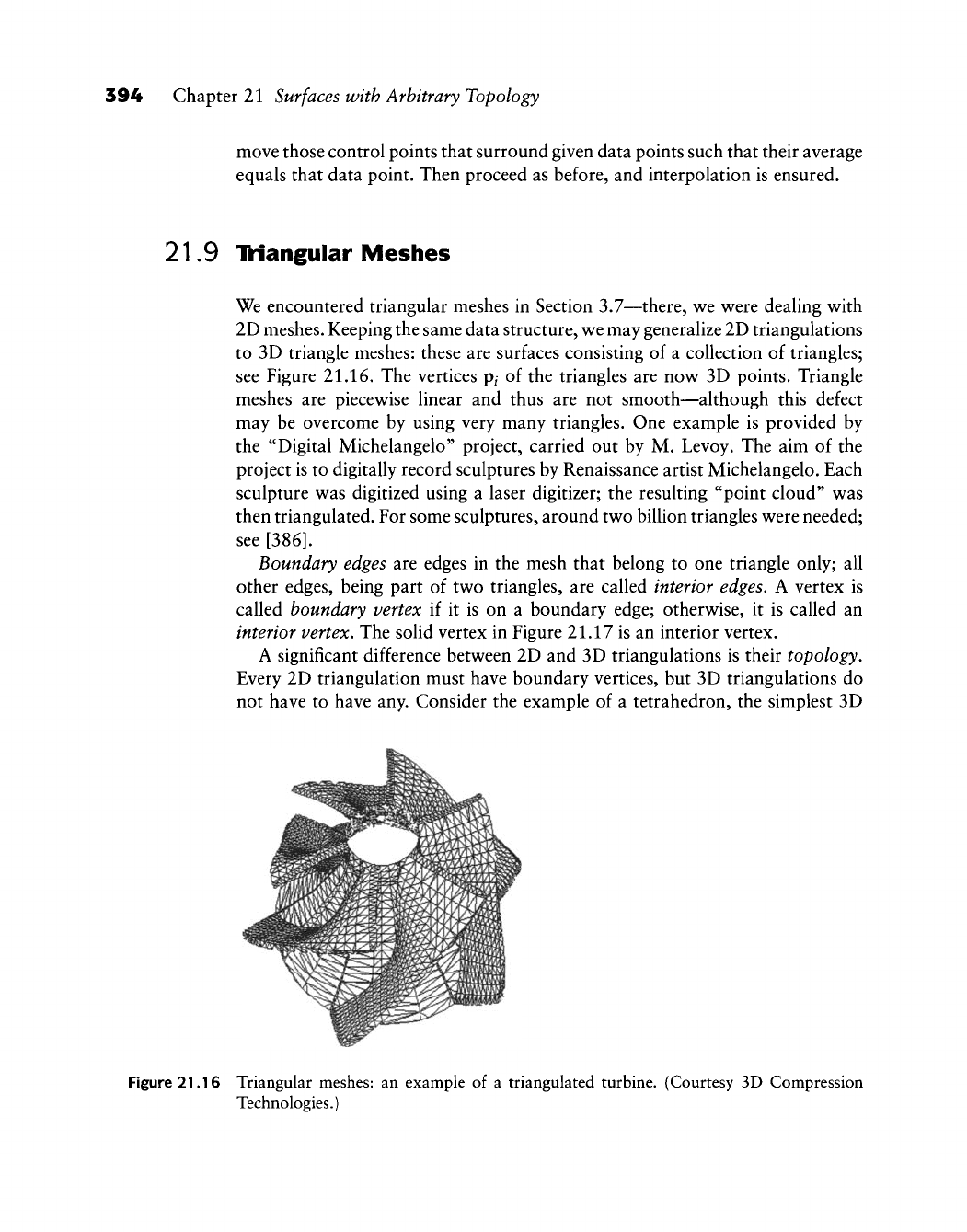
394 Chapter 21 Surfaces with Arbitrary Topology
move those control points that surround given data points such that their average
equals that data point. Then proceed as before, and interpolation is ensured.
21.9 IV'iangular Meshes
We encountered triangular meshes in Section 3.7—there, we v^ere deahng with
2D meshes. Keeping the same data structure, we may generalize 2D triangulations
to 3D triangle meshes: these are surfaces consisting of a collection of triangles;
see Figure 21.16. The vertices p^ of the triangles are now 3D points. Triangle
meshes are piecewise linear and thus are not smooth—although this defect
may be overcome by using very many triangles. One example is provided by
the "Digital Michelangelo" project, carried out by M. Levoy. The aim of the
project is to digitally record sculptures by Renaissance artist Michelangelo. Each
sculpture was digitized using a laser digitizer; the resulting "point cloud" was
then triangulated. For some sculptures, around two billion triangles were needed;
see
[386].
Boundary edges are edges in the mesh that belong to one triangle only; all
other edges, being part of two triangles, are called interior edges. A vertex is
called boundary vertex if it is on a boundary edge; otherwise, it is called an
interior vertex. The solid vertex in Figure 21.17 is an interior vertex.
A significant difference between 2D and 3D triangulations is their topology.
Every 2D triangulation must have boundary vertices, but 3D triangulations do
not have to have any. Consider the example of a tetrahedron, the simplest 3D
Figure 21.16 Triangular meshes: an example of a triangulated turbine. (Courtesy 3D Compression
Technologies.)
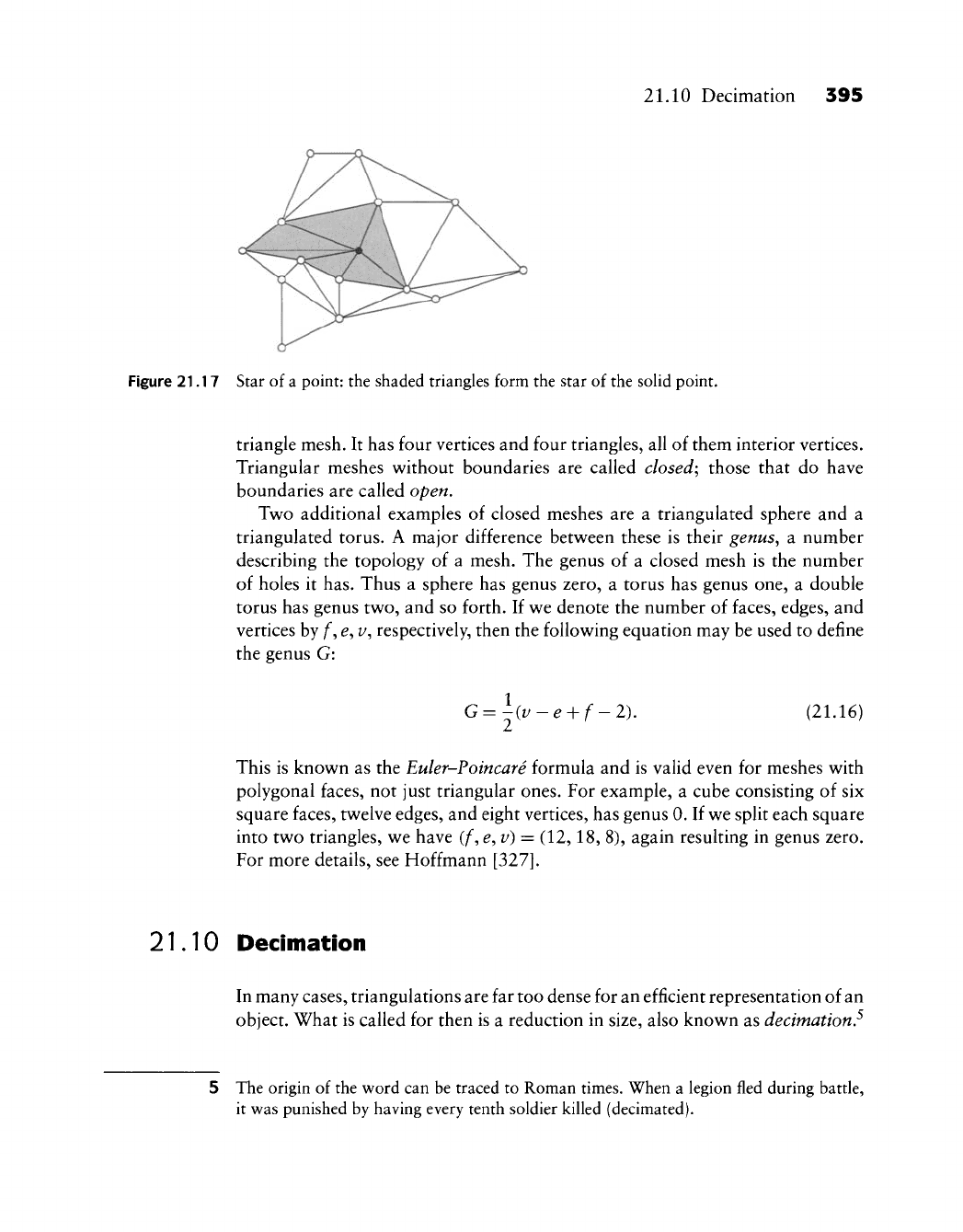
21.10 Decimation 395
Figure 21.17 Star of a point: the shaded triangles form the star of the soHd point.
triangle mesh. It has four vertices and four triangles, all of them interior vertices.
Triangular meshes without boundaries are called
closed;
those that do have
boundaries are called open.
Two additional examples of closed meshes are a triangulated sphere and a
triangulated torus. A major difference between these is their genus^ a number
describing the topology of a mesh. The genus of a closed mesh is the number
of holes it has. Thus a sphere has genus zero, a torus has genus one, a double
torus has genus two, and so forth. If we denote the number of faces, edges, and
vertices by f^
e^
v^
respectively, then the following equation may be used to define
the genus G:
G=hv-e^f
-1). (21.16)
This is known as the Euler-Foincare formula and is valid even for meshes with
polygonal faces, not just triangular ones. For example, a cube consisting of six
square faces, twelve edges, and eight vertices, has genus 0. If we split each square
into two triangles, we have (/^, ^, v) = (12,18, 8), again resulting in genus zero.
For more details, see Hoffmann
[327].
21.10 Decimation
In many cases, triangulations are far too dense for an efficient representation of an
object. What is called for then is a reduction in size, also known as decimation,^
5 The origin of the word can be traced to Roman times. When a legion fled during battle,
it was punished by having every tenth soldier killed (decimated).
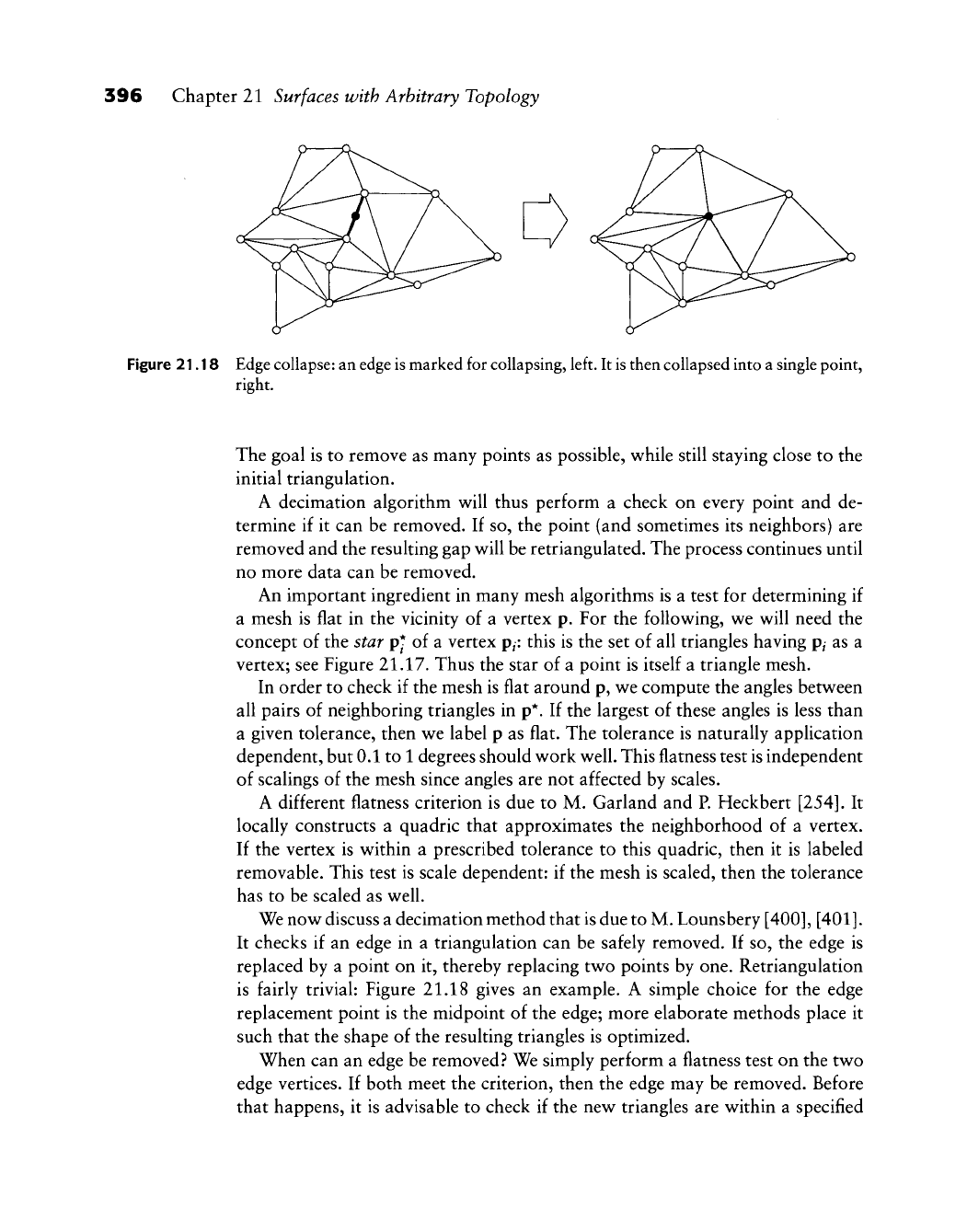
396 Chapter 21 Surfaces with Arbitrary Topology
Figure 21.18 Edge
collapse:
an edge
is
marked for collapsing, left. It
is
then collapsed into a single point,
right.
The goal is to remove as many points as possible, while still staying close to the
initial triangulation.
A decimation algorithm will thus perform a check on every point and de-
termine if it can be removed. If so, the point (and sometimes its neighbors) are
removed and the resulting gap will be retriangulated. The process continues until
no more data can be removed.
An important ingredient in many mesh algorithms is a test for determining if
a mesh is flat in the vicinity of a vertex p. For the following, we will need the
concept of the star p* of a vertex
p^:
this is the set of all triangles having p^ as a
vertex; see Figure 21.17. Thus the star of a point is itself a triangle mesh.
In order to check if the mesh is flat around p, we compute the angles between
all pairs of neighboring triangles in p*. If the largest of these angles is less than
a given tolerance, then we label p as flat. The tolerance is naturally application
dependent, but 0.1 to
1
degrees should work well. This flatness test is independent
of scalings of the mesh since angles are not affected by scales.
A different flatness criterion is due to M. Garland and P. Heckbert
[254].
It
locally constructs a quadric that approximates the neighborhood of a vertex.
If the vertex is within a prescribed tolerance to this quadric, then it is labeled
removable. This test is scale dependent: if the mesh is scaled, then the tolerance
has to be scaled as well.
We now discuss a decimation method that is due to M. Lounsbery
[400], [401].
It checks if an edge in a triangulation can be safely removed. If so, the edge is
replaced by a point on it, thereby replacing two points by one. Retriangulation
is fairly trivial: Figure 21.18 gives an example. A simple choice for the edge
replacement point is the midpoint of the edge; more elaborate methods place it
such that the shape of the resulting triangles is optimized.
When can an edge be removed? We simply perform a flatness test on the two
edge vertices. If both meet the criterion, then the edge may be removed. Before
that happens, it is advisable to check if the new triangles are within a specified
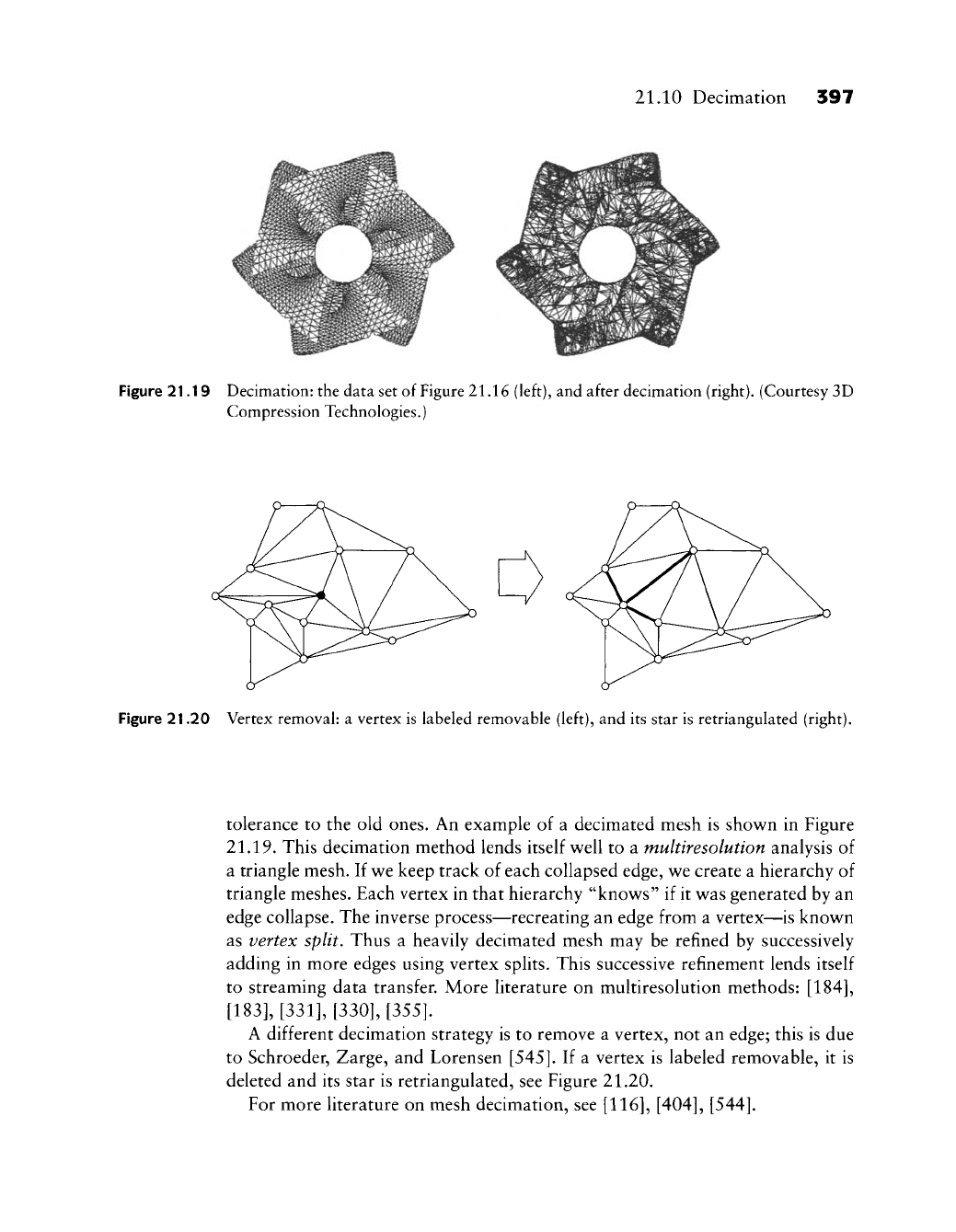
21.10 Decimation 397
Figure 21.19 Decimation: the data set of Figure 21.16 (left), and after decimation (right). (Courtesy 3D
Compression Technologies.)
Figure 21.20 Vertex removal: a vertex is labeled removable (left), and its star is retriangulated (right).
tolerance to the old ones. An example of a decimated mesh is shown in Figure
21.19.
This decimation method lends itself well to a multiresolution analysis of
a triangle mesh. If we keep track of each collapsed edge, we create a hierarchy of
triangle meshes. Each vertex in that hierarchy "knows" if it was generated by an
edge collapse. The inverse process—recreating an edge from a vertex—is known
as vertex split. Thus a heavily decimated mesh may be refined by successively
adding in more edges using vertex splits. This successive refinement lends itself
to streaming data transfer. More literature on multiresolution methods:
[184],
[183], [331], [330], [355].
A different decimation strategy is to remove a vertex, not an edge; this is due
to Schroeder, Zarge, and Lorensen
[545].
If a vertex is labeled removable, it is
deleted and its star is retriangulated, see Figure 21.20.
For more literature on mesh decimation, see
[116], [404], [544].
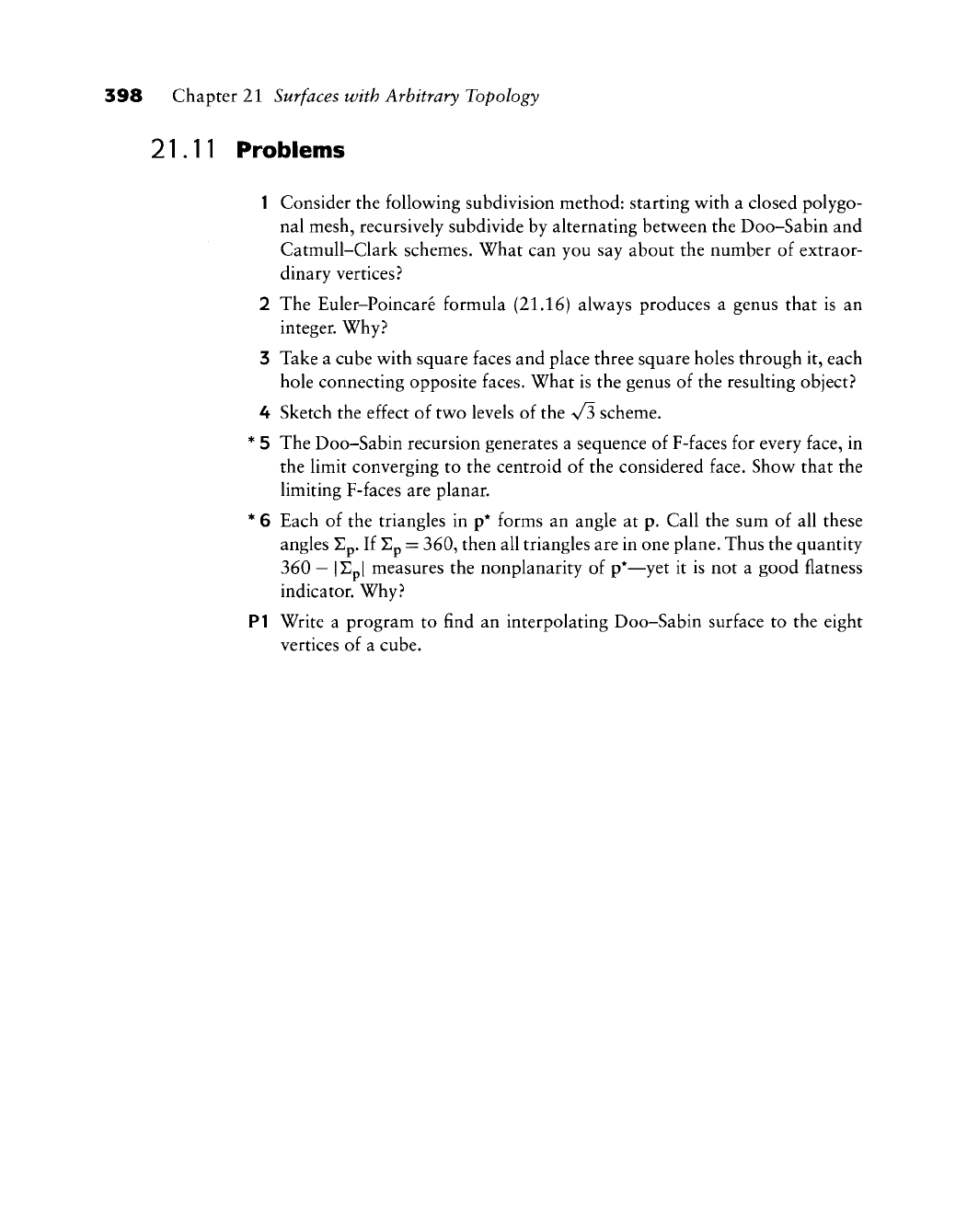
398 Chapter 21 Surfaces with Arbitrary Topology
21.11 Problems
1 Consider the following subdivision method: starting with a closed polygo-
nal mesh, recursively subdivide by alternating between the Doo-Sabin and
CatmuU-Clark schemes. What can you say about the number of extraor-
dinary vertices?
2 The Euler-Poincare formula (21.16) always produces a genus that is an
integer. Why.^
3 Take a cube with square faces and place three square holes through it, each
hole connecting opposite faces. What is the genus of the resulting object.^
4 Sketch the effect of two levels of the >/3 scheme.
* 5 The Doo-Sabin recursion generates a sequence of F-faces for every face, in
the limit converging to the centroid of the considered face. Show that the
limiting F-faces are planar.
* 6 Each of the triangles in p* forms an angle at p. Call the sum of all these
angles Ep. If Ep = 360, then all triangles are in one plane. Thus the quantity
360
— I Dpi
measures the nonplanarity of p*—yet it is not a good flatness
indicator. Why?
PI Write a program to find an interpolating Doo-Sabin surface to the eight
vertices of a cube.
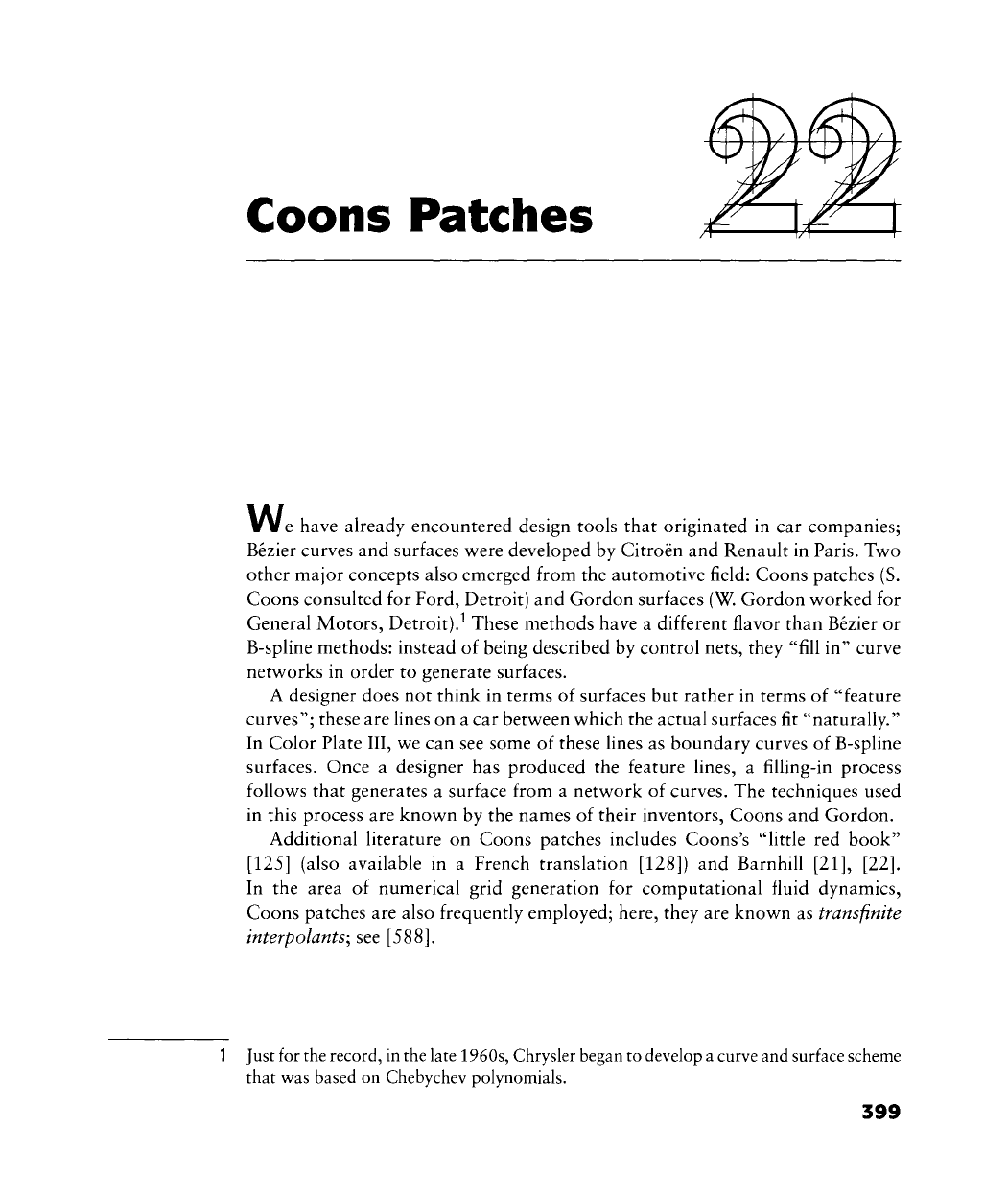
Coons Patches
w e have already encountered design tools that originated in car companies;
Bezier curves and surfaces were developed by Citroen and Renault in Paris. Two
other major concepts also emerged from the automotive field: Coons patches (S.
Coons consulted for Ford, Detroit) and Gordon surfaces (W. Gordon worked for
General Motors, Detroit).^ These methods have a different flavor than Bezier or
B-spline methods: instead of being described by control nets, they "fill in" curve
networks in order to generate surfaces.
A designer does not think in terms of surfaces but rather in terms of "feature
curves"; these are lines on a car between which the actual surfaces fit "naturally."
In Color Plate III, we can see some of these lines as boundary curves of B-spline
surfaces. Once a designer has produced the feature lines, a filling-in process
follows that generates a surface from a network of curves. The techniques used
in this process are known by the names of their inventors. Coons and Gordon.
Additional literature on Coons patches includes Coons's "little red book"
[125] (also available in a French translation [128]) and Barnhill [21], [22].
In the area of numerical grid generation for computational fluid dynamics.
Coons patches are also frequently employed; here, they are known as transfinite
interpolants; see
[588].
1 Just for the record, in the late 1960s, Chrysler began to develop a curve and surface scheme
that was based on Chebychev polynomials.
399
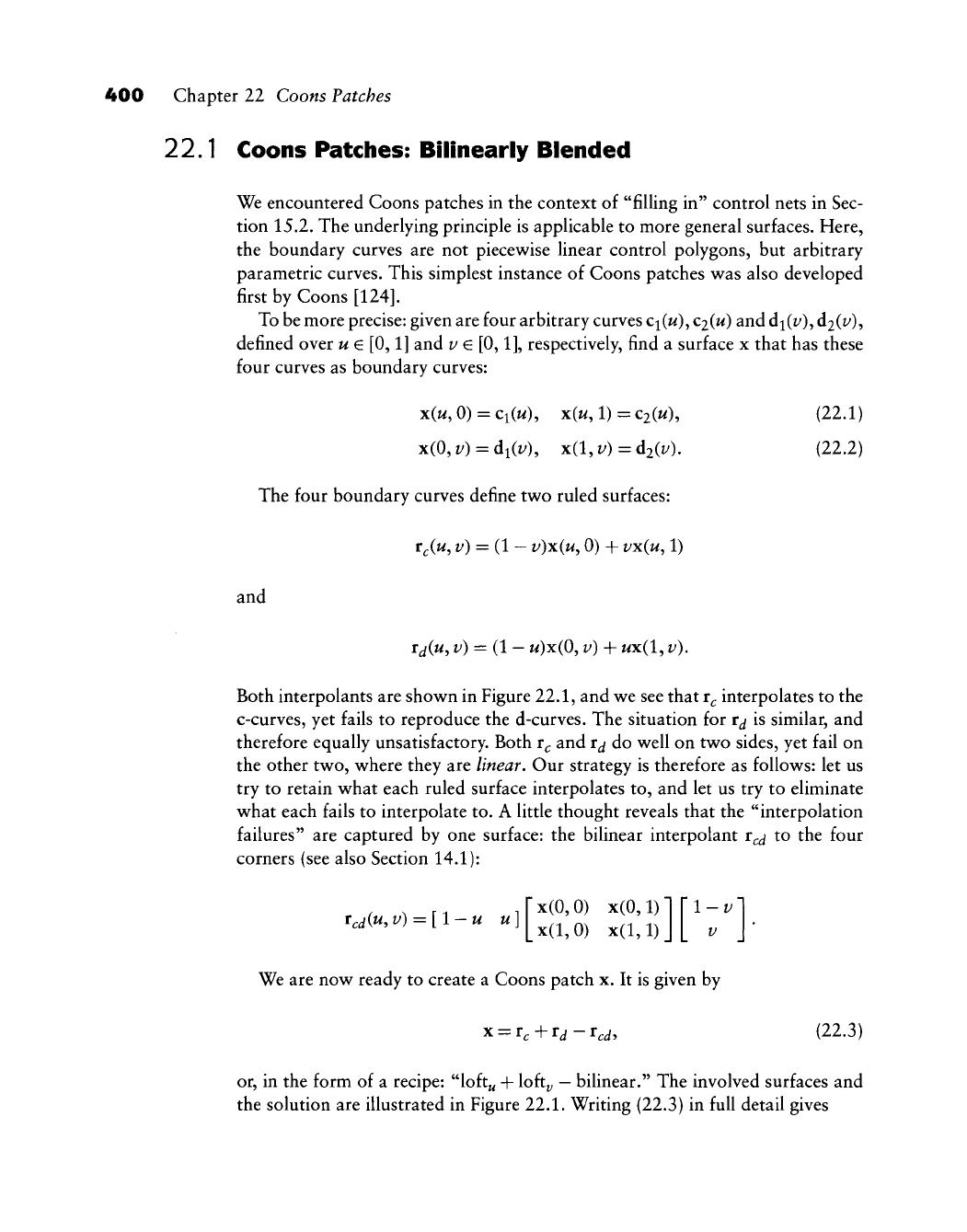
400 Chapter 22 Coons Patches
22.1 Coons Patches: Bilinearly Blended
We encountered Coons patches in the context of "fiUing in" control nets in Sec-
tion 15.2. The underlying principle is applicable to more general surfaces. Here,
the boundary curves are not piecewise linear control polygons, but arbitrary
parametric curves. This simplest instance of Coons patches was also developed
first by Coons
[124].
To be more precise: given are four arbitrary curves Ci(u), Ciiu) and di(t'),
diiv),
defined over
w
G
[0,1] and v e
[0,1],
respectively, find a surface x that has these
four curves as boundary curves:
x(w, 0) = Ci(w), x(w, 1) = C2(w), (22.1)
x(0,
v) = di(i/), x(l, v) = d2iv), (22.2)
The four boundary curves define two ruled surfaces:
r^(w, v) = (1
—
v)x(u^ 0) + vx(u, 1)
and
r^(w, i;) = (1 - w)x(0, v) + wx(l, v).
Both interpolants are shown in Figure
22.1,
and we see that r^ interpolates to the
c-curves, yet fails to reproduce the d-curves. The situation for r^ is similar, and
therefore equally unsatisfactory. Both r^ and r^ do well on two sides, yet fail on
the other two, where they are linear. Our strategy is therefore as follows: let us
try to retain what each ruled surface interpolates to, and let us try to eliminate
what each fails to interpolate to. A little thought reveals that the "interpolation
failures" are captured by one surface: the bilinear interpolant v^d ^^ ^he four
corners (see also Section 14.1):
. X r. if x(0,0) x(0,1) 1 r 1 - 1/1
We are now ready to create a Coons patch x. It is given by
x = r^ + rj-r^^, (22.3)
or, in the form of a recipe: "loft^ + loft^
—
bilinear." The involved surfaces and
the solution are illustrated in Figure 22.1. Writing (22.3) in full detail gives
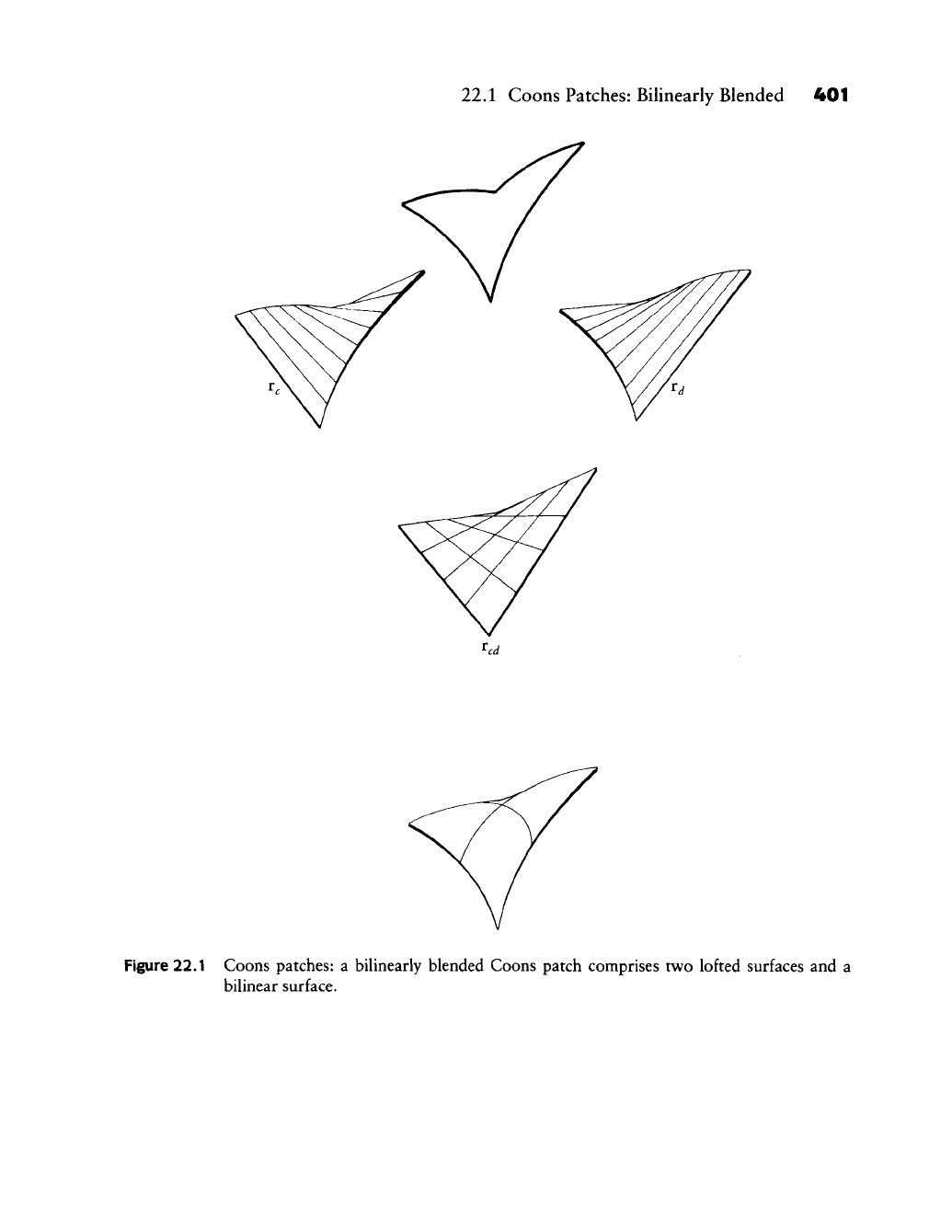
22.1 Coons Patches: Bilineariy Blended 401
Figure 22.1 Coons patches: a biUnearly blended Coons patch comprises two lofted surfaces and a
bilinear surface.
